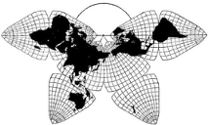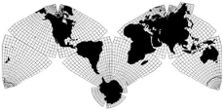
Cahill 1909

Cahill-Keyes 1975

Cahill 1909
|
Go back to
Gene Keyes home page
Cahill-Keyes 1975 |
|
Why Cahill? What about Buckminster Fuller?
Evolution of the Dymaxion Map: An Illustrated Tour and Critique Part 9.7-b by Gene Keyes 2009-06-15 CONTENTS
Click inside boxes to open other sections in separate windows. 9) Critique: Seven Design Flaws of Fuller's
Map as Compared to Cahill's
|
|
Part 9.7-b
Learnability: synoptic view, globe and map (continued) |
|
Appendix 2
The close relation of Cahill's octants to a globe Now we see the critical learnability difference
between the Fuller and Cahill globes. In the latter instance, I simply
labeled the octants from 1 to 8, and did not have to bother with edge
and vertex numbering. My logic was to start at (1) the North Pacific
octant with the dateline, proceed eastward to (2) North America, to (3)
Europe and northern Africa, to (4) Asia, then move southward to (5) Australia,
and go eastward again to (6) New Zealand and South Pacific, to (7) South
America, and to (8) southern Africa. (Matching my M-shaped layout, left to right.)
I am showing two comparison-pairs for each octant: A) In color, the Replogle globe which I marked to 5°, plus the spherical triangles: matched with the flat octants in a reduction to 12.5%, from Cahill's largest world map (and the only one in color). Alas, this early draft of his from 1914 only has a 10° x 15° grid. Therefore, I added: B) In black and white, a computer drafted 5° orthographic globe projection, with octant lines enhanced, matched to separate octants from Cahill's 5° unpublished equal-area Version "C", from 1936. Caveat: be aware that the Cahill octants are off by half a degree compared to the Cahill-Keyes globe images, because of the aforementioned revision, whereby I divide the globe from 20° W, rather than Cahill's 22 1/2° W, so as to avoid half-degree geocells. I could have portrayed the globe's natural size, but since there are so many images on this page, I'm staying with 1/100,000,000, which reduces the ten-inch globe as if to five inches, like my Fullerized globe above. Note: The orthographic projection globe-like
maps appear larger than their counterpart globe-photos at the
same scale, because an orthographic is seen from "infinity", whereas
a similar "perspective" projection, much closer, like the photos, does
not quite include an entire hemisphere.
Sources for all images in this series:
Replogle 10 inch globe, 1975; 5° grid and Cahill octants superimposed by Gene Keyes, 2009; photos by GK, 2009 Computer prints of orthographic globes from R.L. Parker's "Supermap" program output [from punchcards!] and octants added by Gene Keyes, 1975; scanned by GK, 2009 Single octants in color from B.J.S. Cahill's largest
and unpublished* world map, ca. 1914. (See details and very big full-size panels on my separate web pages.) Black-and-white octants reduced from Cahill's 1936 unpublished* equal-area Version "C". (See Part 9.2, Fig. 9.2.1.) *Note: these two draft Cahill maps from his archive, items 57 and 61, at University of California, Berkeley, are now presented here on this website for the very first time. |
| Cahill-Keyes
Octant 1 N. Pacific 
|
Cahill Octant 1 N. Pacific 
|

|

|
Cahill-Keyes Octant 2 N. America 
|
Cahill Octant 2 N. America 
|

|

|
Cahill-Keyes Octant 3 Europe & N. Africa 
|
Cahill Octant 3 Europe & N. Africa 
|

|
|
Cahill-Keyes Octant 4 Asia 
|
Cahill Octant 4 Asia 
|

|

|
Cahill-Keyes Octant 5 Australia 
|
Cahill Octant 5 Australia 
|

|

|
Cahill-Keyes Octant 6 S. Pacific 
|
Cahill Octant 6 S. Pacific 
|

|

|
Cahill-Keyes Octant 7 S. America 
|
Cahill Octant 7 S. America 
|

|

|
Cahill-Keyes Octant 8 S. Africa 
|
Cahill Octant 8 S. Africa 
|

|

|
|
And just for good measure, I will repeat and
juxtapose a pair of Fuller and Cahill globe / map images:
|
| Cahill-Keyes Octant 4 Asia 
|
Cahill Octant 4 Asia 
|
|
Fuller [split] triangle 12 on a globe
Southeast Asia and Oceania 
|
Fuller [split] triangle 12
Southeast Asia and Oceania 
|
|
Compared to Fuller's icosahedral, I think the
Cahill world map design does a lot more with a lot less (in terms of facets).
Next, on the last page, are some brief closing thoughts.
|